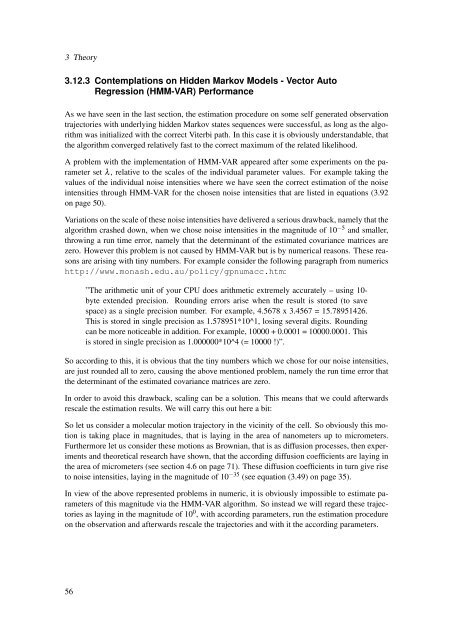Diffusion Processes with Hidden States from ... - FU Berlin, FB MI
Diffusion Processes with Hidden States from ... - FU Berlin, FB MI
Diffusion Processes with Hidden States from ... - FU Berlin, FB MI
Create successful ePaper yourself
Turn your PDF publications into a flip-book with our unique Google optimized e-Paper software.
3 Theory3.12.3 Contemplations on <strong>Hidden</strong> Markov Models - Vector AutoRegression (HMM-VAR) PerformanceAs we have seen in the last section, the estimation procedure on some self generated observationtrajectories <strong>with</strong> underlying hidden Markov states sequences were successful, as long as the algorithmwas initialized <strong>with</strong> the correct Viterbi path. In this case it is obviously understandable, thatthe algorithm converged relatively fast to the correct maximum of the related likelihood.A problem <strong>with</strong> the implementation of HMM-VAR appeared after some experiments on the parameterset λ, relative to the scales of the individual parameter values. For example taking thevalues of the individual noise intensities where we have seen the correct estimation of the noiseintensities through HMM-VAR for the chosen noise intensities that are listed in equations (3.92on page 50).Variations on the scale of these noise intensities have delivered a serious drawback, namely that thealgorithm crashed down, when we chose noise intensities in the magnitude of 10 −5 and smaller,throwing a run time error, namely that the determinant of the estimated covariance matrices arezero. However this problem is not caused by HMM-VAR but is by numerical reasons. These reasonsare arising <strong>with</strong> tiny numbers. For example consider the following paragraph <strong>from</strong> numericshttp://www.monash.edu.au/policy/gpnumacc.htm:”The arithmetic unit of your CPU does arithmetic extremely accurately – using 10-byte extended precision. Rounding errors arise when the result is stored (to savespace) as a single precision number. For example, 4.5678 x 3.4567 = 15.78951426.This is stored in single precision as 1.578951*10^1, losing several digits. Roundingcan be more noticeable in addition. For example, 10000 + 0.0001 = 10000.0001. Thisis stored in single precision as 1.000000*10^4 (= 10000 !)”.So according to this, it is obvious that the tiny numbers which we chose for our noise intensities,are just rounded all to zero, causing the above mentioned problem, namely the run time error thatthe determinant of the estimated covariance matrices are zero.In order to avoid this drawback, scaling can be a solution. This means that we could afterwardsrescale the estimation results. We will carry this out here a bit:So let us consider a molecular motion trajectory in the vicinity of the cell. So obviously this motionis taking place in magnitudes, that is laying in the area of nanometers up to micrometers.Furthermore let us consider these motions as Brownian, that is as diffusion processes, then experimentsand theoretical research have shown, that the according diffusion coefficients are laying inthe area of micrometers (see section 4.6 on page 71). These diffusion coefficients in turn give riseto noise intensities, laying in the magnitude of 10 −35 (see equation (3.49) on page 35).In view of the above represented problems in numeric, it is obviously impossible to estimate parametersof this magnitude via the HMM-VAR algorithm. So instead we will regard these trajectoriesas laying in the magnitude of 10 0 , <strong>with</strong> according parameters, run the estimation procedureon the observation and afterwards rescale the trajectories and <strong>with</strong> it the according parameters.56









